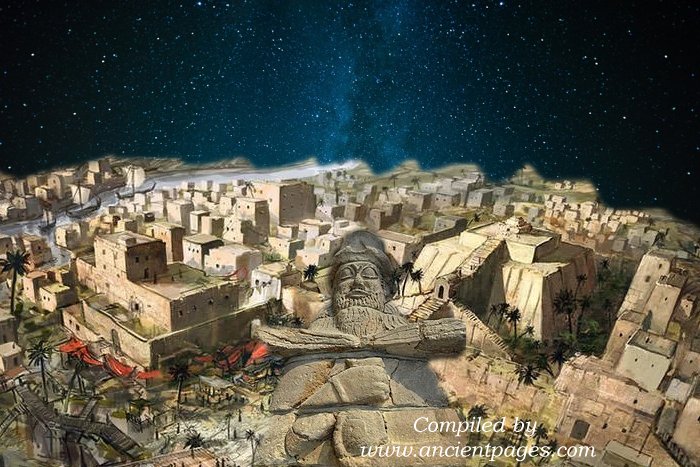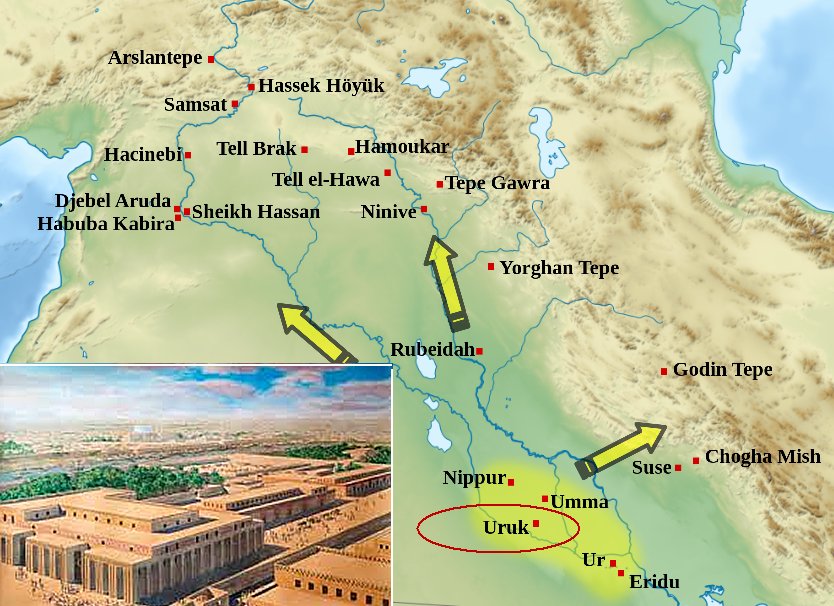Uruk Prophecy Found In The Ancient Library Of A Magician With Divine Powers
Ellen Lloyd - AncientPages.com - In 1969, members of the German Warka expedition discovered an ancient damaged clay tablet in Uruk, the first city built by Gilgamesh about 4,000 years ago. Examination of this interesting ancient artifact revealed it contained what today is known as the Uruk Prophecy.
Later, scientists unearthed several other old clay tablets. These Sumerian inscriptions were once part of an ancient library belonging to Anu-iksur, a magician who was said to have had divine powers.
Although badly broken, scientists managed to read and translate the inscriptions carved on the clay tablet that contained the Uruk prophecy. It was a very interesting text describing the arrival of an unjust king who would make life miserable for people and bring terror to the whole world.
According to legends, the ancient Sumerian city of Uruk was built by Gilgamesh, a demigod of superhuman strength. The city of Uruk was originally built for Anu, the father of the gods, and his daughter, Inanna, the goddess of love and war. Gilgamesh also irrigated the fields, dug wells, and made orchards.
One of his greatest achievements was the construction of the city walls of Uruk to defend his people from enemies.
One side of the tablet with the Uruk Prophecy reveals life became hard in the city and elsewhere in the land. There was no rightful heir to succeed to the throne, and there was a king who, instead of ruling the country, spent months in his palace. Due to the damage, it’s difficult to gain information about the events taking place in Mesopotamia at the time, but the other side of the tablet is better preserved, and it gave researchers a good opportunity to learn more about this ancient prophecy left to future generations.
“On it, a series of kings is predicted. First, a king from the Sealand who ruled in Babylon will come to reign over the devastated part of the land. Then there will be an unjust king who will remove the ancient protective goddess of Uruk and make her dwell in Babylon, placing in her sanctuary in Uruk another, improper goddess. The unjust king will impose heavy taxes upon Uruk and devaste her; next, another unjust king will arise.
Line 8 begins with KI.MIN (“ditto”) written five times and ends with the statement, surely about a king, “He will take the property of Babylonia to Assyria.” Next, an unjust king will arise who will establish the rites of Anu in Uruk and restore Uruk’s protective goddess to her own sanctuary; he will renew and glorify Uruk, and after him his son will be the king in Uruk and become master of the world (lines 11-16). 1
Ancient Sumerians and Babylonians constantly observed the night skies and were very skilled astronomers. Many of their prophecies were influenced by celestial objects and events they witnessed in the night sky. However, the Uruk Prophecy differs from the Marduk Prophecy which we discussed in an earlier article.
As one example, we can mention that “the Uruk Prophecy and Dynastic Prophecy all refer to Babylonia as Akkad; the Marduk and Sulgi Prophecies, on the other hand, do not mention Akkad at all and have numerous references to Babylon. Babylon is referred to in the Uruk Prophecy as SU.AN.NA.KI and in the Dynastic Prophecy as DIN.TIR.KI. Assur occurs in the Marduk and Sulgi Prophecies and in the Dynastic Prophecy, but not in the others.” 2
It is an interesting observation, especially if we consider the fact that the ancient city of Ashur, (also known as Assur) was the first capital and powerful religious center of the Assyrian Empire.
Who the author of the intriguing Uruk Prophecy was is still a mystery, but he apparently claimed to be someone of divine origin.
Updated on February 21, 2024
Written by Ellen Lloyd – AncientPages.com
Copyright © AncientPages.com All rights reserved. This material may not be published, broadcast, rewritten or redistributed in whole or part without the express written permission of AncientPages.com
Expand for references- Goldstein, Jonathan A. "The Historical Setting of the Uruk Prophecy." Journal of Near Eastern Studies47, no. 1 (1988): 43-46.
- Biggs, Robert D. "The Babylonian Prophecies and the Astrological Traditions of Mesopotamia." Journal of Cuneiform Studies37, no. 1 (1985): 86-90. doi:10.2307/1359960.
More From Ancient Pages
-
 Isaac Newton Believed Egyptian Pyramids Held Key To The Apocalypse – Unpublished Manuscripts Reveal
News | Dec 10, 2020
Isaac Newton Believed Egyptian Pyramids Held Key To The Apocalypse – Unpublished Manuscripts Reveal
News | Dec 10, 2020 -
 Very Rare Discovery: Viking Age Mortuary House Unearthed In Central Norway
Archaeology | Sep 29, 2019
Very Rare Discovery: Viking Age Mortuary House Unearthed In Central Norway
Archaeology | Sep 29, 2019 -
 Justinianic Plague Struck England Before It Reached Constantinople And It Did Not Wipe Out The Roman Empire
Archaeology | Nov 19, 2021
Justinianic Plague Struck England Before It Reached Constantinople And It Did Not Wipe Out The Roman Empire
Archaeology | Nov 19, 2021 -
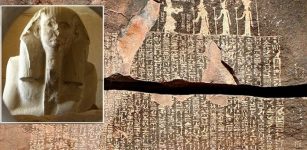 Djoser – Most Outstanding King Of The Third Dynasty In Ancient Egypt And His Step Pyramid
Featured Stories | Sep 7, 2021
Djoser – Most Outstanding King Of The Third Dynasty In Ancient Egypt And His Step Pyramid
Featured Stories | Sep 7, 2021 -
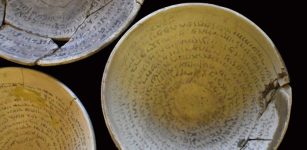 Ancient Magical Bowls Inscribed With Spells And Other Rare Artifacts Seized In Jerusalem Raid
Archaeology | Mar 14, 2022
Ancient Magical Bowls Inscribed With Spells And Other Rare Artifacts Seized In Jerusalem Raid
Archaeology | Mar 14, 2022 -
 Unexplained Phenomenon In Ancient Ireland – When Legends, Science And Real Events Collide
Featured Stories | Apr 19, 2018
Unexplained Phenomenon In Ancient Ireland – When Legends, Science And Real Events Collide
Featured Stories | Apr 19, 2018 -
 Undeciphered Ancient Symbols On Boulders In Pennsylvania And New England Could Be An Ancient Diary Of Forgotten Civilizations And Events
Featured Stories | Jul 4, 2024
Undeciphered Ancient Symbols On Boulders In Pennsylvania And New England Could Be An Ancient Diary Of Forgotten Civilizations And Events
Featured Stories | Jul 4, 2024 -
 USC Archeologist Discovers Maya Royal Burial Site
Archaeology | Jan 9, 2016
USC Archeologist Discovers Maya Royal Burial Site
Archaeology | Jan 9, 2016 -
 Face Of Norwegian Boy Who Lived 8,000 Years Ago Reconstructed
Archaeology | Mar 16, 2023
Face Of Norwegian Boy Who Lived 8,000 Years Ago Reconstructed
Archaeology | Mar 16, 2023 -
 Mythical Beautiful Adarna Bird And Its Harmful Magical Power In Mythology Of Philippines
Myths & Legends | Jan 25, 2017
Mythical Beautiful Adarna Bird And Its Harmful Magical Power In Mythology Of Philippines
Myths & Legends | Jan 25, 2017 -
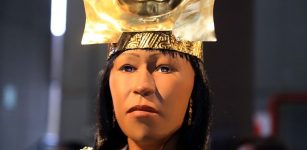 Face Of Queen Lady Cao Reconstructed – Unique Look At The First Known Female Ruler In Peru
Archaeology | Jul 10, 2017
Face Of Queen Lady Cao Reconstructed – Unique Look At The First Known Female Ruler In Peru
Archaeology | Jul 10, 2017 -
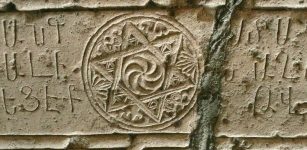 Ancient Iconic Armenian Wheel Of Eternity Depicted Inside A Six Pointed Star
Ancient Symbols | Feb 27, 2017
Ancient Iconic Armenian Wheel Of Eternity Depicted Inside A Six Pointed Star
Ancient Symbols | Feb 27, 2017 -
 Suprising Evolution Discovery – Human Temporal Lobes Are Not Very Large In Comparison With Other Primates
Archaeology | Mar 21, 2023
Suprising Evolution Discovery – Human Temporal Lobes Are Not Very Large In Comparison With Other Primates
Archaeology | Mar 21, 2023 -
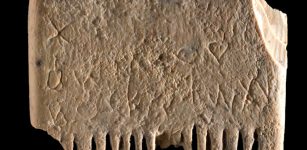 Breakthrough – First Sentence Ever Written In Canaanite Language Discovered – What Does It Say?
Archaeology | Nov 9, 2022
Breakthrough – First Sentence Ever Written In Canaanite Language Discovered – What Does It Say?
Archaeology | Nov 9, 2022 -
 Neolithic Farmers Invented Methods To Fight Pests 8,000 Years Ago
Archaeology | Jun 30, 2022
Neolithic Farmers Invented Methods To Fight Pests 8,000 Years Ago
Archaeology | Jun 30, 2022 -
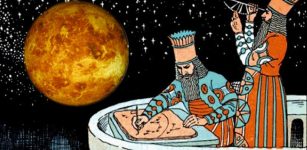 Elusive Planet Mercury As Seen Through The Eyes Of Ancient Astronomers
Archaeoastronomy | Dec 31, 2018
Elusive Planet Mercury As Seen Through The Eyes Of Ancient Astronomers
Archaeoastronomy | Dec 31, 2018 -
 Mystery Of Pre-Adamic Didanum Race: Giants Who Were Ancestors Of The Nephilim and Rephaim
Biblical Mysteries | Oct 2, 2014
Mystery Of Pre-Adamic Didanum Race: Giants Who Were Ancestors Of The Nephilim and Rephaim
Biblical Mysteries | Oct 2, 2014 -
 Rare Viking Age Treasure Found By Woman Cleaning The House
Archaeology | Apr 20, 2023
Rare Viking Age Treasure Found By Woman Cleaning The House
Archaeology | Apr 20, 2023 -
 A Scientist’s Powerful Dream Revealed An Extraordinary Archaeological Discovery
Featured Stories | Jan 25, 2019
A Scientist’s Powerful Dream Revealed An Extraordinary Archaeological Discovery
Featured Stories | Jan 25, 2019 -
 The Face Of The Amarakarei – Remarkable Enormous Face Caved Into Stone Cliffs In Peru
Places | Nov 20, 2015
The Face Of The Amarakarei – Remarkable Enormous Face Caved Into Stone Cliffs In Peru
Places | Nov 20, 2015

